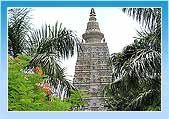| Call Us Fax No. |
+(91) - 9717929990 +(91)-(124)-4635544 : mail@toptravelindia.com, topindia@gmail.com |

| Call Us Fax No. |
+(91) - 9717929990 +(91)-(124)-4635544 : mail@toptravelindia.com, topindia@gmail.com |

| home | about us | hotels | car rental | India Holidays Tours | international holidays |

Service |

 It's
not only the one-horned rhinos of Kaziranga that call for a visit to the
northeastern Indian state of Assam. It's expansive tea plantations
contribute almost 60% of the total tea produce of the country. Globally, the
state finds itself responsible for 15.6% of the world's tea production. It's
close location to countries like Bhutan and China has made it a potpourri of
numerous races and cultures. The mighty Brahamputra River predominates the
state. Assam also happens to be the easiest accessible destination in the
northeastern India.
It's
not only the one-horned rhinos of Kaziranga that call for a visit to the
northeastern Indian state of Assam. It's expansive tea plantations
contribute almost 60% of the total tea produce of the country. Globally, the
state finds itself responsible for 15.6% of the world's tea production. It's
close location to countries like Bhutan and China has made it a potpourri of
numerous races and cultures. The mighty Brahamputra River predominates the
state. Assam also happens to be the easiest accessible destination in the
northeastern India.  Assam
has been a melting point of various ethnic groups and cultural entities. The
Brahamputra Valley can prove to be a good example of this eclectic mix.
Moving towards the south, in the Barak Valley, you will come to meet the
Bengali-speaking communities along with the tribal folks who have equally
contributed to making the culture of the state richer. The tea garden
community happens to be an assimilation of people from states like Bihar,
Orissa, Tamil Nadu and Kerala who migrated here during the British Rule.
Therefore, it is now evident that the Assamese are a mix of various ethnic
groups. Broadly speaking, the population of Assam can be classified as
tribals and non-tribal people. Assamese, Hindi and English are the major
languages spoken here.
Assam
has been a melting point of various ethnic groups and cultural entities. The
Brahamputra Valley can prove to be a good example of this eclectic mix.
Moving towards the south, in the Barak Valley, you will come to meet the
Bengali-speaking communities along with the tribal folks who have equally
contributed to making the culture of the state richer. The tea garden
community happens to be an assimilation of people from states like Bihar,
Orissa, Tamil Nadu and Kerala who migrated here during the British Rule.
Therefore, it is now evident that the Assamese are a mix of various ethnic
groups. Broadly speaking, the population of Assam can be classified as
tribals and non-tribal people. Assamese, Hindi and English are the major
languages spoken here. | India Destination | Tourist Attractions | India Holidays Tours | Neighbouring Country | India Travel Guide |
|
© Sai Holidays. All Rights Reserved (Terms
of Use) |